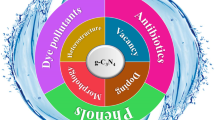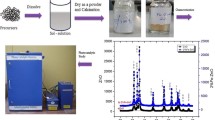Abstract
To obtain cheap, low-toxic, efficient and robust visible-light photocatalyst, a controlled calcination strategy is proposed for converting unstable ZnX (X=Se, Te) nanospheres (NSs) to ZnX–ZnO hybrid nanospheres (HNSs) with an appropriate composition and structure. Under such a conception, ZnSe–ZnO HNSs with various compositions were prepared by calcining ZnSe NSs under different conditions. Their morphology, composition, crystal structure, and optical absorption property were found to be highly dependent on their calcination condition. When serving as the catalyst for photodegrading organic dyes, they exhibited an attractive composition/structure-dependent photocatalytic activity and enhanced photostability. Particularly, the HNSs prepared by calcining at 500 °C for 4.0 h demonstrated the highest photocatalytic activity and excellent photostability, only taking 4.5 and 5.5 h to degrade 97.3 % methylene blue (MB) and 93 % ethyl violet (EV), respectively, under visible irradiation. The reason why such HNSs possessed the best photocatalytic performance was then intensively explored from different points of view. Moreover, we also extended this calcination protocol to prepare ZnTe–ZnO HNSs, whose photocatalytic performance was proven to be much better than that of pure ZnTe NSs as expected. We believe the strategy for fabricating such hybrid nanospheres and the exploration on their excellent photocatalytic performance will definitely benefit the preparation of high-efficient visible-light catalyst as well as the better understanding of its composition/structure-dependent photocatalytic activity.











Similar content being viewed by others
References
Aksu Z (2005) Binary System dye removal from colored textile wastewater using activated carbon: kinetic and isotherm studies. Process Biochem 40:997–1026
Vimonses V, Lei S, Jin B (2009) Kinetic study and equilibrium isotherm analysis of congo red adsorption by clay materials. Chem Eng J 148:354–364
Chen CC, Ma WH, Zhao JC (2010) Semiconductor-mediated photodegradation of pollutants under visible-light irradiation. Chem Soc Rev 39:4206–4219
Mahmoodi NM, Salehi R, Arami M (2011) Application of biosorption for the removal of organic pollutants: a review. Desalination 272:187–195
Neppolian BH, Choi C, Sakthivel S, Arabindoo B, Murugesan V (2002) Solar/UV-induced photocatalytic degradation of three commercial textile dyes. J Hazard Mater 89:303–317
Chakrabarti S, Dutta BK (2004) Photocatalytic degradation of model textile dyes in wastewater using ZnO as semiconductor catalyst. J Hazard Mater 112:269–278
Mohagheghian A, Karimi SA, Yang JK, Shirzad-Siboni M (2015) Photocatalytic degradation of a textile dye by illuminated tungsten oxide nanopowder. J Adv Oxid Technol 18:61–68
Farrokhi M, Hosseini SC, Yang JK, Shirzad-Siboni M (2014) Application of ZnO–Fe3O4 nanocomposite on the removal of azo dye from aqueous solutions: kinetics and equilibrium studies. Water Air Soil Pollut 225:1–12
Shirzad-Siboni M, Khataee A, Vahid BW, Joo S, Fallah S (2014) Preparation of a green photocatalyst by immobilization of synthesized ZnO nanosheets on scallop shell for degradation of an azo dye. Curr Nanosci 10:684–694
Siboni MS, Samarghandi M, Yang JK, Lee SM (2011) Photocatalytic removal of reactive black-5 dye from aqueous solution by UV irradiation in aqueous TiO2: equilibrium and kinetics study. J Adv Oxid Technol 14:302–307
Xiong ZG, Zhang LL, Ma JZ, Zhao XS (2010) Photocatalytic degradation of dyes over graphene-gold nanocomposites under visible light irradiation. Chem Commun 46:6099–6101
Hwang DW, Cha KY, Kim J, Kim HG, Bae SW, Lee JS (2003) Photocatalytic degradation of CH3Cl over a Nickel-loaded layered perovskite. Ind Eng Chem Res 42:1184–1189
Coleman HM, Chiang K, Amal R (2005) Effects of Ag and Pt on photocatalytic degradation of endocrine disrupting chemicals in water. Chem Eng J 113:65–72
Abdelaal MY, Mohamed RM (2013) Novel Pd/TiO2 nanocomposite prepared by modified sol–gel method for photocatalytic degradation of methylene blue dye under visible light irradiation. J Alloy Compd 576:201–207
Yin R, Luo QZ, Wang DS, Sun HT, Li YY, Li XY, An J (2014) SnO2/g-C3N4 photocatalyst with enhanced visible-light photocatalytic activity. J Mater Sci 49:6067–6073. doi:10.1007/s10853-014-8330-0
Zhang N, Zhang YH, Xu YJ (2012) Recent progress on metal core@semiconductor shell nanocomposites as a promising type of photocatalyst. Nanoscale 4:2227–2238
Jonidi-Jafari A, Shirzad-Siboni M, Yang JK, Naimi-Joubani M, Farrokhi M (2015) Photocatalytic degradation of diazinon with illuminated ZnO–TiO2 composite. J Taiwan Inst Chem Eng 50:100–107
Zhang YH, Chen Z, Liu SQ, Xu YJ (2013) Size effect induced activity enhancement and anti-photocorrosion of reduced graphene oxide/ZnO composites for degradation of organic dyes and Reduction of Cr(VI) in water. Appl Catal B Environ 140–141:598–607
Carvalho HWP, Batista APL, Bertholdo R, Santilli CV, Pulcinelli SH, Ramalho TC (2010) Photocatalyst TiO2–Co: the effect of doping depth profile on methylene blue degradation. J Mater Sci 45:5698–5703. doi:10.1007/s10853-010-4639-5
Yu JG, Su YR, Cheng B (2007) Template-free fabrication and enhanced photocatalytic activity of hierarchical macro-/mesoporous titania. Adv Funct Mater 17:1984–1990
Wang DS, Shi L, Luo QZ (2012) An efficient visible light photocatalyst prepared from TiO2 and polyvinyl chloride. J Mater Sci 47:2136–2145. doi:10.1007/s10853-011-6014-6
Yu B, Lau WM, Yang J (2013) Preparation and characterization of N–TiO2 photocatalyst with high crystallinity and enhanced photocatalytic inactivation of bacteria. Nanotechnology 24:335705
Zhang J, Xu LJ, Zhu ZQ, Liu QJ (2015) Synthesis and properties of (Yb, N)-TiO2 photocatalyst for degradation of methylene blue (MB) under visible light irradiation. Mater Res Bull 70:358–364
Wang Z, Yin L, Zhang M, Zhou GW, Fei H, Shi HX, Dai HJ (2014) Synthesis and characterization of Ag3PO4/multiwalled carbon nanotube composite photocatalyst with enhanced photocatalytic activity and stability under visible light. J Mater Sci 49:1585–1593. doi:10.1007/s10853-013-7841-4
Yao WF, Zhang B, Huang CP, Ma C, Song XL, Xu QJ (2012) Synthesis and characterization of high efficiency and stable Ag3PO4/TiO2 visible light photocatalyst for the degradation of methylene blue and rhodamine B Solutions. J Mater Chem 22:4050–4055
Long MC, Cai WM, Kisch H (2009) Template-free synthesis of BiVO4 nanostructures: II. Relationship between various microstructures for monoclinic BiVO4 and their photocatalytic activity for the degradation of rhodamine B under visible light. Nanotechnology 20:405602
Guan ML, Ma DK, Cai J, Hu SW, Chen YJ, Huang SM (2011) From hollow olive-shaped BiVO4 to n-p core-shell BiVO4@Bi2O3 microspheres: controlled synthesis and enhanced visible-light-responsive photocatalytic properties. Inorg Chem 50:800–805
Cho S, Jang JW, Lee JS, Lee KH (2012) Porous ZnO–ZnSe nanocomposites for visible light photocatalysis. Nanoscale 4:2066–2071
Liu CZ, Wang YX, Meng DW, Yu XH, Wang YQ, Liu J, Lu C, Xu K (2014) Enhanced visible light photocatalytic performance of ZnO/ZnS/CuS ternary nanocomposites. Mater Lett 122:197–200
Lee M, Yong K (2012) Highly efficient visible light photocatalysis of novel CuS/ZnO heterostructure nanowire arrays. Nanotechnology 23:194014
Zeng B, Chen XH, Chen CS, Ning XT, Deng WN (2014) Reduced graphene oxides loaded-ZnS/CuS heteronanostructures as high-activity visible-light-driven photocatalysts. J Alloy Compd 58:2774–2779
Tong ZW, Yang D, Shi JF, Nan YH, Sun YY, Jiang ZY (2015) There-dimensional porous aerogel constructed by g-C3N4 and graphene oxide nanosheets with excellent visible-light photocatalytic performance. ACS Appl Mater Inter 7:25693–25701
Wang DS, Xu ZX, Luo QZ, Li XY, An J, Yin R, Bao C (2016) Preparation and visible-light photocatalytic performances of g-C3N4 surface hybridized with a small amount of CdS nanoparticles. J Mater Sci 51:893–902. doi:10.1007/s10853-015-9417-y
Xu M, Han L, Dong SJ (2013) Facile fabrication of highly efficient g-C3N4/Ag2O heterostructure. ACS Appl Mater Inter 5:12533–12540
Ehsan MF, Ashiq MN, He T (2015) Hollow and mesoporous ZnTe microspheres: synthesis and visible-light photocatalytic reduction of carbon dioxide into methane. RSC Adv 5:6186–6194
Cao HQ, Xiao YJ, Zhang SC (2011) The synthesis and photocatalytic activity of ZnSe microspheres. Nanotechnology 22:015604
Wu XP, Gu J, Zhou SM, Li XY, Wang SL, Jin L, Chen H, Shi JJ (2015) Red bayberry-like ZnTe microstructures: controlled synthesis, growth mechanism and enhanced photocatalytic performance. J Alloy Compd 627:166–173
Wu X, Xu R, Zhu RJ, Wu R, Zhang B (2015) Converting 2D inorganic-organic ZnSe-DETA hybrid nanosheets into 3D hierarchical nanosheet-based ZnSe microspheres with enhanced visible-light-driven photocatalytic performances. Nanoscale 7:975–979
Bicelli LP (1992) Thermodynamic stability of n-cadmium telluride in photoelectrochemical. Cells J Phys Chem 96:9995–10001
Bozzini B, Maffi S, D’ Urzo L, Bicelli LP (2009) Thermodynamics of the photocorrosion of n-ZnSe and p-ZnTe. Corros Rev 27:83–115
Hodes G, Miller B (1986) Thermodynamic stability of II–VI semiconductor-polysulfide photoelectrochemical systems. J Electrochem Soc 133:2177–2180
Bhattacharya C, Datta J (2005) Studies on anodic corrosion of the electroplated CdSe in aqueous and non-aqueous media for photoelectrochemical cells and characterization of the electrode/electrolyte interface. Mat Chem Phys 89:170–175
Jiang F, Li YC, Ye MF, Fan LZ, Ding YQ, Li YF (2010) Ligand-tuned shape control, oriented assembly, and electrochemical characterization of colloidal ZnTe nanocrystals. Chem Mater 22:4632–4641
Yang WT, Liu XL, Li D, Fan LZ, Li YC (2015) Aggregation-induced preparation of ultrastable zinc sulfide colloidal nanospheres and their photocatalytic degradation of multiple organic dyes. Phys Chem Chem Phys 17:14532–14541
Zhong HZ, Wei ZX, Ye MF, Yan Y, Zhou Y, Ding YQ, Yang CH, Li YF (2007) Monodispersed ZnSe colloidal microspheres: preparation, characterization, and their 2D Arrays. Langmuir 23:9008–9013
Fermı´n DJ, Ponomarev EA, Peter LM (1999) A kinetic study of CdS photocorrosion by intensity modulated photocurrent and photoelectrochemical impedance spectroscopy. J Electroanal Chem 473:192–203
Zenia F, Lévy-Clément C, Triboulet R, Könenkamp R, Ernst K, Saad M, Lux-Steiner MC (1999) Electrochemical texturization of ZnTe surfaces. Appl Phys Lett 75:531–533
Tang YH, Hua X, Liu CB (2014) Perfect Inhibition of CdS photocorrosion by graphene sheltering engineering on TiO2 nanotube array for highly stable photocatalytic activity. Phys Chem Chem Phys 16:25321–25329
Zhong HZ, Zhou Y, Yang Y, Yang CH, Li YF (2007) Synthesis of type II CdTe–CdSe nanocrystal heterostructured multiple-branched rods and their photovoltaic applications. J Phys Chem C 111:6538–6543
Wu ZM, Zhang Y, Zheng JJ, Lin XG, Chen XH, Huang BW, Huang K, Liu SP, Kang JY (2011) An all-inorganic type-II heterojunction array with nearly full solar spectral response based on ZnO/ZnSe core/shell nanowires. J Mater Chem 21:6020–6026
Eley C, Li T, Liao FL, Fairclough SM, Smith JM, Smith G, Tsang SCE (2014) Nanojunction-mediated photocatalytic enhancement in herestructured Cd/S, CdSe/ZnO, and CdTe/ZnO nanocrystals. Angew Chem Int Ed 53:7838–7842
Wang Y, Suna A, Mahler W, Kasowaki R (1987) PbS in polymers. From molecules to bulk solids. J Chem Phys 87:7315–7322
Zhu YP, Li J, Ma TY, Liu Y, Du G, Yuan Z (2014) Sonochemistry-assisted synthesis and optical properties of mesoporous ZnS nanomaterials. J Mater Chem A 2:1093–1101
Zhang T, Oyama T, Aoshima A, Hidaka H, Zhao J, Sperpone N (2001) Photooxidative n-demethylation of methylene blue in aqueous TiO2 dispersions under UV irradiation. J Photochem Photobiol A 140:163–172
Zaban A, Greenshtein M, Bisquert J (2003) Determination of the electron lifetime in nanocrystalline dye solar cells by open-circuit voltage decay measurements. Chem Phys Chem 4:859–864
Zhao D, Peng TY, Lu LL, Cai P, Jiang P, Bian ZQ (2008) Effect of annealing temperature on the photoelectrochemical properties of dye-sensitized solar cells made with mesoporous TiO2 nanoparticles. J Phys Chem C 112:8486–8494
Li TL, Lee YL, Teng H (2012) High-performance quantum dot-Sensitized solar cells based on sensitization with CuInS2 quantum dots/CdS heterostructure. Energy Environ Sci 5:5315–5324
Chen C, Ma W, Zhao J (2010) Semiconductor-mediated photodegradation of pollutants under visible-light irradiation. Chem Soc Rev 39:4206–4219
Qu P, Zhao J, Shen T, Hidaka H (1998) TiO2-assisted photodegradation of dyes: a study of two competitive primary processes in the degradation of RB in an aqueous TiO2 colloidal solution. J Mol Catal A: Chem 129:257–268
Acknowledgements
This work was financially supported by the Natural Science Foundation of China [NSFC, 21273020, 21003012, 91023039, and 21233003 (the State Key Program)].
Author information
Authors and Affiliations
Corresponding author
Electronic supplementary material
Below is the link to the electronic supplementary material.
10853_2016_406_MOESM1_ESM.docx
Supplementary material 1 Including HRTEM, XRD, EDS, and Raman and XPS spectra of ZnSe or ZnTe nanospheres, N2 adsorption isotherms, XRD, and photodegradation assays of ZnSe NSs and ZnSe–ZnO HNSs; TOC and ICP analysis of dye solutions; SEM images and photodegradation assays of ZnTe and ZnTe–ZnO NSs (DOCX 8603 kb)
Rights and permissions
About this article
Cite this article
Liu, X., Li, D., Yang, W. et al. Controlled calcination of ZnSe and ZnTe nanospheres to prepare visible-light catalysts with enhanced photostability and photoactivity. J Mater Sci 51, 11021–11037 (2016). https://doi.org/10.1007/s10853-016-0406-6
Received:
Accepted:
Published:
Issue Date:
DOI: https://doi.org/10.1007/s10853-016-0406-6




